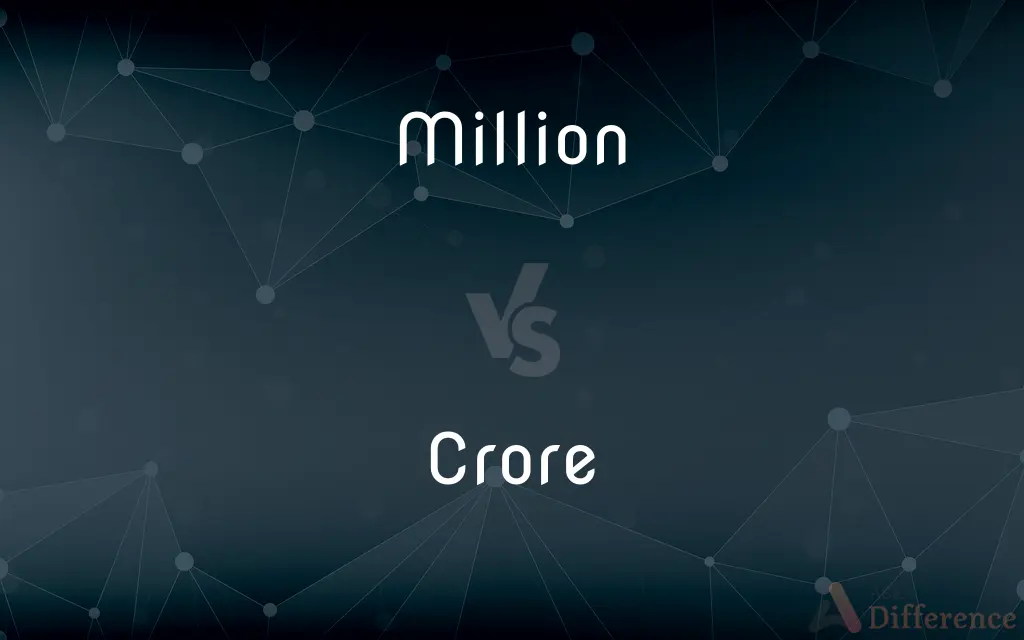Million vs. Crore — What's the Difference?
By Urooj Arif & Maham Liaqat — Updated on March 14, 2024
A million represents 1,000,000 units, while a crore signifies 10,000,000 units, primarily used in the Indian numbering system.

Difference Between Million and Crore
Table of Contents
ADVERTISEMENT
Key Differences
In the international numbering system, a million is widely recognized and represents one thousand thousand, or 1,000,000. In contrast, a crore is part of the South Asian numbering system, particularly in India and neighboring countries, representing ten million, or 10,000,000 units. This difference highlights the variance in numerical representation and scale used in different regions.
While the term million is universally used in scientific, financial, and international contexts, a crore is specific to certain countries and is used alongside lakhs in place of millions and billions. This localization in numbering systems reflects cultural and historical preferences in numerical categorization.
In financial transactions or when discussing population, economy size, or other large-scale quantitative measures internationally, millions are commonly used. On the other hand, crores are employed in similar discussions within the South Asian context, making it essential to understand the conversion when comparing or analyzing data across different regions.
The transition from millions to billions in the international system occurs after 1,000 millions, whereas in the Indian system, it progresses from 1 crore to 10 crores, and then to 1 arab (or 100 crores), showcasing a different scaling approach in large number nomenclature.
Understanding the distinction and conversion between millions and crores is crucial in global communication, especially in financial, academic, and demographic contexts, to ensure clarity and avoid misinterpretation of figures across different numbering systems.
ADVERTISEMENT
Comparison Chart
Numerical Value
1,000,000
10,000,000
System
International numbering system
Indian (South Asian) numbering system
Usage
Global, especially in scientific and financial contexts
Primarily in India and neighboring countries
Scale Transition
From million to billion after 1,000 millions
From crore to arab after 100 crores
Localization
Used universally
Used in specific regions, reflecting local preferences
Compare with Definitions
Million
A numerical value representing 1,000,000 units.
The city's population has grown to 2 million people.
Crore
A numerical value used in the Indian numbering system, equal to 10,000,000.
The country's GDP is estimated at 5 crores INR.
Million
A standard unit in the international numbering system.
The project requires an investment of 1 million dollars.
Crore
Commonly used in India and neighboring countries for large-scale quantification.
The population of the metropolitan area is 1.5 crores.
Million
Used globally in financial and scientific contexts.
The company's revenue reached $5 million last quarter.
Crore
Reflects large numbers, especially in economic and demographic discussions.
The film grossed over 100 crores at the box office.
Million
A term used to describe large quantities or scales.
The charity raised millions of dollars for disaster relief.
Crore
Indicates a significant scale or quantity within the regional context.
Over 2 crores of people participated in the festival.
Million
Indicates a significant amount or number.
The video has been viewed over a million times.
Crore
Part of a unique counting system, paired with 'lakh'.
The budget for the new infrastructure project is 20 crores.
Million
The cardinal number equal to 106.
Crore
A crore (; abbreviated cr), kodi, khokha, karod, karor, or koti denotes ten million (10,000,000 or 107 in scientific notation) and is equal to 100 lakh in the Indian numbering system. It is written as 1,00,00,000 with the local 2,2,3 style of digit group separators (one lakh is equal to one hundred thousand, and is written as 1,00,000).
Million
A million monetary units, such as dollars
Made a million in the stock market.
Crore
Ten million
Worth three crore fifty lakh rupees.
A cost of over several crores.
Million
Often millions An indefinitely large number
Millions of bicycles on the road.
Crore
(India) ten million; 10,000,000; or with Indian digit grouping, 1,00,00,000. Often used with units of money.
Following the ban, the government stands to lose ₹30 crore annually, sources said. (India Times, 2nd July 2003)
The population of Gujarat is 3.39 crores.
Million
Often millions The common people; the masses
Entertainment for the millions.
Crore
Ten millions; as, a crore of rupees (which is nearly $5,000,000).
Million
The cardinal number 1,000,000: 106; a thousand thousand.
Crore
The number that is represented as a one followed by 7 zeros; ten million
Million
An unspecified very large number.
I told you a million times before.
I can think of millions of reasons not to go.
Million
The number of ten hundred thousand, or a thousand thousand, - written 1,000,000. See the Note under Hundred.
Million
A very great number; an indefinitely large number.
Millions of truths that a man is not concerned to know.
Million
The mass of common people; - with the article the.
For the play, I remember, pleased not the million.
Million
The number that is represented as a one followed by 6 zeros
Million
(in Roman numerals, M written with a macron over it) denoting a quantity consisting of 1,000,000 items or units
Common Curiosities
What is the main difference between a million and a crore?
A million is equal to 1,000,000 units, while a crore equals 10,000,000 units, with the latter primarily used in the Indian numbering system.
How is the transition from millions to the next scale different from crores?
In the international system, the transition is from million to billion after 1,000 millions, while in the Indian system, it moves from crore to arab after 100 crores.
How do digital platforms accommodate these numbering differences?
Many digital platforms offer localization options, displaying numbers in the preferred format of the user, be it millions or crores.
How is the concept of a million perceived in countries that use crores?
In countries that use crores, millions are understood and used in international contexts or when referring to global standards and data.
How do millions and crores fit into their respective numbering systems?
Millions are part of the international numbering system, scaling up from thousands, while crores are used in the Indian system, following lakhs and preceding arabs.
Can the terms million and crore be used interchangeably?
Due to their different values, they cannot be used interchangeably without conversion, especially in contexts involving international communication.
Why is it important to understand the difference between millions and crores?
Understanding the difference is crucial for accurate data interpretation, financial transactions, and global communications, avoiding confusion in numerical representations.
What challenges might arise in international finance due to these differences?
In international finance, conversion between crores and millions/billions is essential to ensure clarity and prevent misinterpretation of financial figures.
What role do crores play in the Indian economy?
Crores are commonly used in discussing large-scale economic transactions, budget allocations, and GDP figures within the Indian context.
What tools can help with the conversion between millions and crores?
Various online calculators and conversion tools can assist in converting between millions and crores for accurate comparisons and calculations.
Is the use of crores common outside of the Indian subcontinent?
The use of crores is largely confined to the Indian subcontinent and is not commonly used in other regions.
How do educational systems in India approach the concept of millions and billions?
Indian educational systems teach both the Indian and international numbering systems, ensuring students are familiar with both million/billion and lakh/crore denominations.
Is there a trend towards standardizing numerical representations globally?
While there is a trend towards standardization in global finance and science, local numbering systems like crores remain in use for regional relevance and cultural significance.
How do businesses operating internationally deal with these numerical differences?
International businesses often use standardized financial reporting in millions and billions, but may also provide local equivalents in crores for clarity in regional communications.
Are there any historical reasons for the difference in numbering systems?
The differences arise from historical and cultural developments in mathematics and numeracy, with regions developing their own systems based on linguistic and commercial practices.
Share Your Discovery

Previous Comparison
Amphipathic vs. Amphiphilic
Next Comparison
Armature vs. RotorAuthor Spotlight
Written by
Urooj ArifUrooj is a skilled content writer at Ask Difference, known for her exceptional ability to simplify complex topics into engaging and informative content. With a passion for research and a flair for clear, concise writing, she consistently delivers articles that resonate with our diverse audience.
Co-written by
Maham Liaqat















































